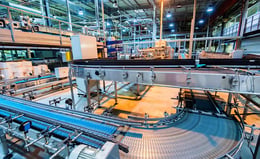How Real-time Decision-making Will Change Your Whole Supply Chain
Brian Hoey - November 22, 2018

 Let us consider the smart fridge. This modern convenience, part of the much-vaunted Internet of Things and a key component of many smart homes, give you the ability to track its contents and see them displayed via smart phone or tablet when you’re away from home. To some, this might seem like somewhat of a frivolous piece of technology, but imagine the following scenario: you’re at the grocery store, doing your weekly stocking up; you have a whole shopping list full of items that you expect to be depleted within the next few days, from eggs and butter to fresh produce. What you’re not planning on buying is milk, because when you left the house you still had most of a gallon left. Then, all of a sudden, you receive an alert from your phone letting you know that you’re out of milk. Unbeknownst to you, your partner has accidentally taken the existing gallon out of the fridge and spilled it. Luckily, she instructed the fridge to send you a real-time update and you were able to add it to your shopping list before you left, saving yourself an extra trip to the store or a week without any milk.
Let us consider the smart fridge. This modern convenience, part of the much-vaunted Internet of Things and a key component of many smart homes, give you the ability to track its contents and see them displayed via smart phone or tablet when you’re away from home. To some, this might seem like somewhat of a frivolous piece of technology, but imagine the following scenario: you’re at the grocery store, doing your weekly stocking up; you have a whole shopping list full of items that you expect to be depleted within the next few days, from eggs and butter to fresh produce. What you’re not planning on buying is milk, because when you left the house you still had most of a gallon left. Then, all of a sudden, you receive an alert from your phone letting you know that you’re out of milk. Unbeknownst to you, your partner has accidentally taken the existing gallon out of the fridge and spilled it. Luckily, she instructed the fridge to send you a real-time update and you were able to add it to your shopping list before you left, saving yourself an extra trip to the store or a week without any milk.
Even at this point, the type of real-time information sharing we’re discussing might not seem like a big deal—after all, it’s just a trip to the grocery store—but if you multiply this added convenience (weighed against the added inconvenience of any disruption or slowdown) to the entire automotive supply chain, you begin to see the transformative power real-time information can have across all touchpoints on the value chain. The question is, what might the integration of real-time into an existing industrial operation look like in practice?
Sourcing from Suppliers
Though the most obvious uses for real-time might be things like up-to-the-minute traffic monitoring or live production insights, the power of real-time to smooth out supply chain operations actually begins with the sourcing of parts and materials. By monitoring changes in demand and pricing as they occur (and by using advanced analytics processes to predict how they’re likely to change in the near future), business can be sure that they’re always getting the best deal on the parts they need, potentially saving money in the process. Moving beyond that, real-time integration has the potential to provide businesses with a comprehensive picture of the inventory levels and part availabilities of various suppliers across the value stream, giving manufacturers a clear picture of resource ability that could enable them to be more proactive about sourcing, to bundle shipments in creative ways, and to generally make the most of an ever-evolving, variant-rich global supply chain. Instead of being shackled to a particular supplier offering limited visibility, you can gain a comprehensive view of your options, and then act accordingly, potentially driving towards leaner and more agile workflows in the process.
Planned Production
While real-time data downstream in the supply chain can help with your mid-term operational planning, real-time production data can have a much more immediate impact on day-to-day supply chain operations. In effect, real-time integration gives manufacturers the power to make sure that everything is going to plan on their production lines, and to react in an appropriate manner when something goes awry. If, for instance, a production planner received a notification that a bottleneck was occurring at a particular point in the production stream, he or she could check on the machine in question and determine whether or not it required maintenance, and what other steps might be appropriate to resolving the situation.
Crucially, this production line data isn’t just useful for spotting and warding off potential disruptions. Rather, it can also help to ensure that your entire operation has access to an accurate picture of your production processes at any given time. Think about it, once the data being used in real-time processes has been accrued, is there any reason for it to be discarded without further use? Of course not! Instead, this data, once collected, can be run through prescriptive analytics processes to help uncover any potential areas of waste or inefficiency, meaning that businesses can work to ward off future disruptions. By the same token, this data can be turned into visualizations that can be shared inter-operationally, helping different teams to cohere around a common vision and a shared understanding of what’s working and what’s not within existing operations. In organizations where this level of cohesion can’t be accomplished, the result is often teams working at cross purposes, resulting in lost value.
Transport Logistics
Okay, you’ve sourced your materials in a smarter way with live demand sensing and price updates, and you’ve improved your production control with real-time production feedback. What happens next? Goods need to be warehoused and then shipped to their ultimate destination. If we think back to our smart fridge for a second, we can consider some benefits of having real-time insights into your inventory levels at all times: namely, planning certainty and the ability to adjust course on the fly—both of which can add real value to transportation management workflows. Let’s say you're planning a shipment of car tires to a client in an environment boasting real-time integration. Before the shipment needs to be loaded into trucks, you check existing inventory levels to ensure that you have the necessary goods on hand. Once everything has been loaded, you monitor live traffic conditions to ensure that your truck is taking the fastest, most efficient route. If at any point things aren’t going to plan, you’re able to identify the problem as it’s unfolding and take steps to address it. Not only is this a huge value-added proposition for manufacturers of all stripes, it is, in a nutshell, how real-time decision-making can change your entire supply chain.
LATEST POSTS
- Understand Circular Economy in The Manufacturing Industry
- How Can Industry 4.0 IT Integration Be Achieved Smoothly?
- The Significance of Order Sequencing in Discrete Manufacturing
- How to improve your Supply Chain Management: The Power of Control Towers
- Optimizing Human Resource Scheduling in Manufacturing: A Technological Approach



